Related Research Articles
ClearType is Microsoft's implementation of subpixel rendering technology in rendering text in a font system. ClearType attempts to improve the appearance of text on certain types of computer display screens by sacrificing color fidelity for additional intensity variation. This trade-off is asserted to work well on LCD flat panel monitors.
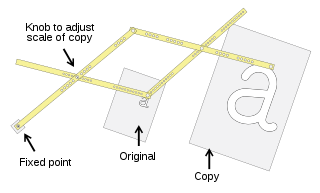
A pantograph is a mechanical linkage connected in a manner based on parallelograms so that the movement of one pen, in tracing an image, produces identical movements in a second pen. If a line drawing is traced by the first point, an identical, enlarged, or miniaturized copy will be drawn by a pen fixed to the other. Using the same principle, different kinds of pantographs are used for other forms of duplication in areas such as sculpting, minting, engraving, and milling.
Steganography is the practice of representing information within another message or physical object, in such a manner that the presence of the information is not evident to human inspection. In computing/electronic contexts, a computer file, message, image, or video is concealed within another file, message, image, or video. The word steganography comes from Greek steganographia, which combines the words steganós, meaning "covered or concealed", and -graphia meaning "writing".

Halftone is the reprographic technique that simulates continuous-tone imagery through the use of dots, varying either in size or in spacing, thus generating a gradient-like effect. "Halftone" can also be used to refer specifically to the image that is produced by this process.

In mathematics, physics, and art, moiré patterns or moiré fringes are large-scale interference patterns that can be produced when a partially opaque ruled pattern with transparent gaps is overlaid on another similar pattern. For the moiré interference pattern to appear, the two patterns must not be completely identical, but rather displaced, rotated, or have slightly different pitch.
In digital signal processing, spatial anti-aliasing is a technique for minimizing the distortion artifacts (aliasing) when representing a high-resolution image at a lower resolution. Anti-aliasing is used in digital photography, computer graphics, digital audio, and many other applications.

In signal processing and related disciplines, aliasing is the overlapping of frequency components resulting from a sample rate below the Nyquist frequency. This overlap results in distortion or artifacts when the signal is reconstructed from samples which causes the reconstructed signal to differ from the original continuous signal. Aliasing that occurs in signals sampled in time, for instance in digital audio or the stroboscopic effect, is referred to as temporal aliasing. Aliasing in spatially sampled signals is referred to as spatial aliasing.

Motion blur is the apparent streaking of moving objects in a photograph or a sequence of frames, such as a film or animation. It results when the image being recorded changes during the recording of a single exposure, due to rapid movement or long exposure.
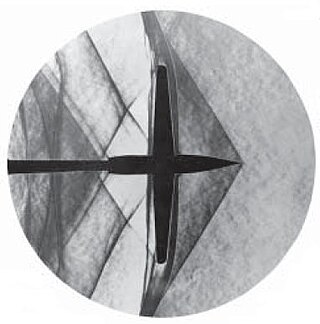
Schlieren photography is a process for photographing fluid flow. Invented by the German physicist August Toepler in 1864 to study supersonic motion, it is widely used in aeronautical engineering to photograph the flow of air around objects.
Subpixel rendering is used to increase the apparent resolution of a computer's display. It takes advantage of the fact that each pixel on a color liquid-crystal display (LCD) or similar is composed of individual red, green, and blue components — subpixels — with different locations, so that the color also causes the image to shift in space.

Security printing is the field of the printing industry that deals with the printing of items such as banknotes, cheques, passports, tamper-evident labels, security tapes, product authentication, stock certificates, postage stamps and identity cards. The main goal of security printing is to prevent forgery, tampering, or counterfeiting. More recently many of the techniques used to protect these high-value documents have become more available to commercial printers, whether they are using the more traditional offset and flexographic presses or the newer digital platforms. Businesses are protecting their lesser-value documents such as transcripts, coupons and prescription pads by incorporating some of the features listed below to ensure that they cannot be forged or that alteration of the data cannot occur undetected.
Dither is an intentionally applied form of noise used to randomize quantization error, preventing large-scale patterns such as color banding in images. Dither is routinely used in processing of both digital audio and video data, and is often one of the last stages of mastering audio to a CD.

In computer graphics, pixelation is caused by displaying a bitmap or a section of a bitmap at such a large size that individual pixels, small single-colored square display elements that comprise the bitmap, are visible. Such an image is said to be pixelated.
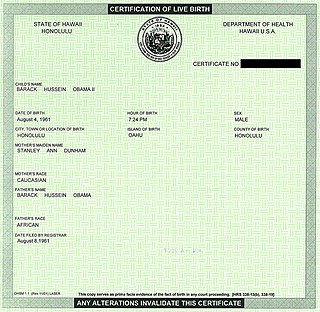
Security paper is a paper used in security printing that incorporates features that can be used to identify or authenticate a document as original, e.g., watermarks or invisible fibres in paper, or features that demonstrate tamper evidence when fraud is attempted, e.g., to remove or alter print such as amounts or signatures on a cheque. Examples of this kind of papers are used for banknotes and used for identification such as passports and certificates, such as birth certificates and different types of academic and qualification certificates, as well as government documents, e.g., voting ballots and tax strips. This also extends to personal and business checks, stock certificates, certificates issued by financial institutions and sensitive government-issued documents. The main use of security paper is to stop people from counterfeiting.
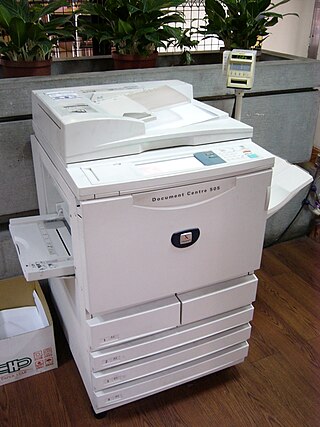
A photocopier is a machine that makes copies of documents and other visual images onto paper or plastic film quickly and cheaply. Most modern photocopiers use a technology called xerography, a dry process that uses electrostatic charges on a light-sensitive photoreceptor to first attract and then transfer toner particles onto paper in the form of an image. The toner is then fused onto the paper using heat, pressure, or a combination of both. Copiers can also use other technologies, such as inkjet, but xerography is standard for office copying.
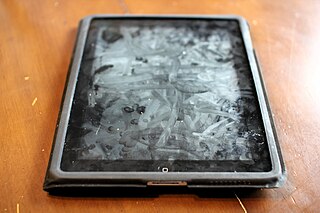
A smudge attack is an information extraction attack that discerns the password input of a touchscreen device such as a cell phone or tablet computer from fingerprint smudges. A team of researchers at the University of Pennsylvania were the first to investigate this type of attack in 2010. An attack occurs when an unauthorized user is in possession or is nearby the device of interest. The attacker relies on detecting the oily smudges produced and left behind by the user's fingers to find the pattern or code needed to access the device and its contents. Simple cameras, lights, fingerprint powder, and image processing software can be used to capture the fingerprint deposits created when the user unlocks their device. Under proper lighting and camera settings, the finger smudges can be easily detected, and the heaviest smudges can be used to infer the most frequent input swipes or taps from the user.
Copy-evident documents have features that make it detectable that a copy is not the original.

A Machine Identification Code (MIC), also known as printer steganography, yellow dots, tracking dots or secret dots, is a digital watermark which certain color laser printers and copiers leave on every printed page, allowing identification of the device which was used to print a document and giving clues to the originator. Developed by Xerox and Canon in the mid-1980s, its existence became public only in 2004. In 2018, scientists developed privacy software to anonymize prints in order to support whistleblowers publishing their work.
Dynamic texture is the texture with motion which can be found in videos of sea-waves, fire, smoke, wavy trees, etc. Dynamic texture has a spatially repetitive pattern with time-varying visual pattern. Modeling and analyzing dynamic texture is a topic of images processing and pattern recognition in computer vision.
A copy detection pattern (CDP) or graphical code is a small random or pseudo-random digital image which is printed on documents, labels or products for counterfeit detection. Authentication is made by scanning the printed CDP using an image scanner or mobile phone camera. It is possible to store additional product-specific data into the CDP that will be decoded during the scanning process. A CDP can also be inserted into a 2D barcode to facilitate smartphone authentication and to connect with traceability data.
References
- 1 2 Aronoff, Jason S.; Simske, Steven J.; et al. (2011). "Automated Optimization of Void Pantograph Settings" (PDF). HP Laboratories (HPL-2011-179). Archived from the original (PDF) on 2021-05-16.
- ↑ Kim, JongWeon; Kim, KyuTae; Lee, JungSoo; Choi, JongUk (2004). "Development of Visible Anti-copy Patterns". Trust and Privacy in Digital Business. Lecture Notes in Computer Science. Vol. 3184. Berlin, Heidelberg: Springer Berlin Heidelberg. pp. 209–218. doi:10.1007/978-3-540-30079-3_22. ISBN 978-3-540-22919-3. ISSN 0302-9743.
- ↑ USpatent 5487567,John R. Volpe,"Printing method and copy-evident secure document"
- ↑ Phillips, George K. (June 3, 2004). New Digital Anti-Copy/Scan and Verification Technologies. Optical Security and Counterfeit Deterrence Techniques V. San Jose, California. p. 133-141. doi:10.1117/12.525500. ISBN 0-8194-5213-0.